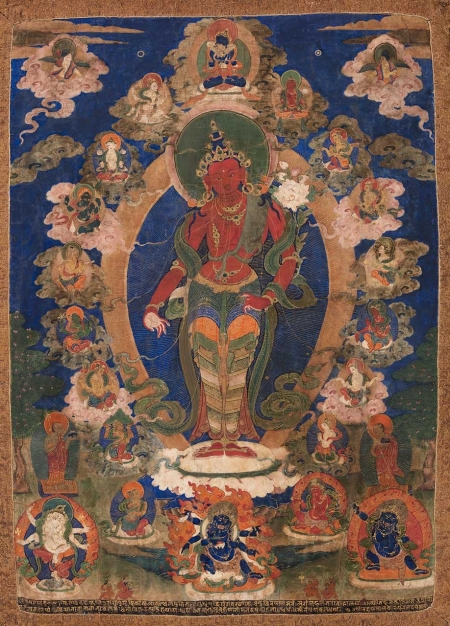
One of the most recognizable mantras in the world is om mani padme hum. While many know it, not all realize that it is associated with the bodhisattva Avalokiteshvara, who has countless forms, both peaceful and wrathful, red and white, with thousands of arms, or maybe just two. Depicted here is the red Avalokiteshvara. Around his radiant body, tethered to his gaze by fine lines of gold, are worldly deities, many originating in the Hindu tradition, such as Shiva, Brahma, Surya, Varuna, Ananta, Chandra, Vishnu, and Agni. This symbolizes his ability to see and manifest his compassion in all realms while all other deities pay homage to him. Painted in warm red hues, he stands against a lapis background with his head at a charming angle. He beckons viewers with his right hand, held in the gesture of generosity.
Rakta Avalokiteshvara is a bodhisattva who has made a vow to remain in the cycle of rebirth through countless lifetimes to work for the benefit of other beings. Bodhisattvas display determination and self-sacrifice, vowing not to pass into the blissful state of Nirvana until all sentient beings are free and accumulating wisdom and merit in order to become buddhas. Practitioners develop this aspiration or “mind of awakening,” also known as bodhichitta, recite mantras, and visualize the deity, aspiring to make their body, speech, and mind indistinguishable from the bodhisattva’s. Red Avalokiteshvara’s appearance is laid out in ritual texts and painted in thangkas to help practitioners with visualization and training of their mind.
At the center bottom of this painting Avalokiteshvara’s wrathful form as the Great Black One with six hands is shown in an aureole of fire. His compassionate nature is unchanged, in spite of the intimidating appearance. His destructive power is aimed at extinguishing the obstacles to spiritual realization.
C2005.29.1, (HAR 65564)
- https://dev.rubinmuseum.org/images/content/6826/c2005.29.1_ptg-4366__zoom.jpg
- https://dev.rubinmuseum.org/images/content/6826/c2005.29.1_ptg-4366__zoom.jpg

